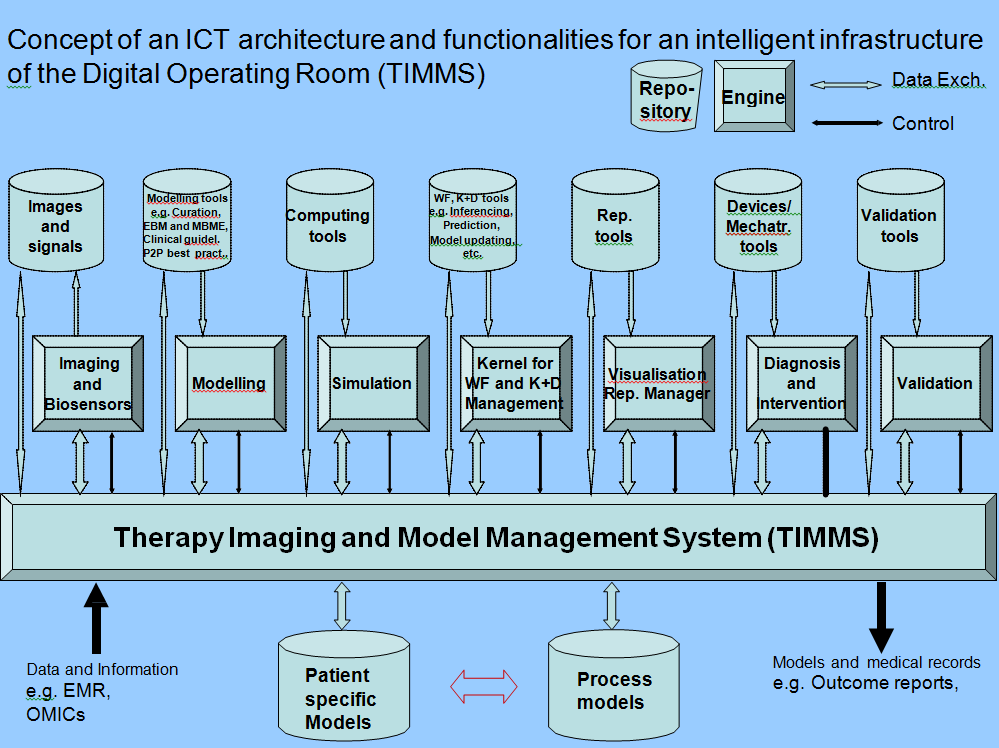
by Heinz U. Lemke, PhD
Part 1 from the last issue is available here.
Part 2 from the last issue is available here.
Part 3: Digital Operating Room (DOR) standards
Since 2003/2004 it was recognized [17,18], that the realization of the “OR of the Future” or DOR, will be a comprehensive undertaking, requiring among others, the development of standards for achieving interoperability of medical devices and systems in the OR. Since then, DICOM and IHE have been considered, in principle, as enablers for fulfilling these requirements.
DICOM In Surgery
DICOM in Surgery, i.e. the DICOM Working Group 24 was founded in 2005 with the aim to develop DICOM objects and services related to Image Guided Surgery (IGS) and related interventions. Its initial roadmap included:
- Select and define a user community of IGS disciplines in WG24. Initially five surgical disciplines (Neuro,
ENT, orthopedics, cardiovascular, thoracoabdominal) and interventional radiology have been selected. Anesthesia is included as long as surgery is affected. - Compile a representative set of surgical workflows (with a suitable high level of granularity and appropriate workflow modeling standards and surgical ontologies) as a work reference for the scope of WG24. Initially, 3-5 workflows, characteristic for each discipline, should be recorded with sufficient level of detail.
- Derive potential DICOM services from these surgical workflows and identify appropriate use cases.
- Design an information model based on electronic medical record (EMR) and related work on patient modeling to identify IOD (Information Object Definition) extensions for DICOM.
- Take account of the special image communication (1D – 5D) requirements for surgery and mechatronic devices. A close cooperation with other Working Groups should be pursued.
- Connect to integration profiles specified in existing IHE domains.
In close cooperation with industry a number of DICOM supplements have been realized in recent years.
Supplement 132- Surface Segmentation
This IOD can be used to encode tissue segmentation, functional segmentation, and artifact identification for quantification or visualization.
Supplement 131- Implant Template
This supplement describes storage, query and retrieval of implant templates (generally non-patient-specific) as they are used in implantation planning.
Supplement 134 – Implantation Plan
The aim of this supplement is to communicate Implantation Planning information from the planning workstation to the operating room.
Supplement 154 – Optical Surface Scanner
This supplement introduces a modality for optical surface scanners. This allows the user the storage and retrieval of scanned surfaces to and from a PACS. Some IGS and DOR related problems are currently under discussion in WG 24 that could lead to work items.
- A Universal Reference Coordinate Standard which helps to freely transfer spatial information between involved devices and systems pre- and intraoperatively.
- A standardized way to communicate patient identity to participating devices in the OR.
vWG 24 is open for discussion for other potential work items, in particular those which may be indentified, for example, in projects such as OR.NET and MD PnP.
IHE Surgery
IHE Surgery was founded in 2012 as a provisional IHE domain [15] after la long preparatory phase by the sponsoring organisations, the International Foundation of CARS and the International Society for Computer Aided Surgery. The scope and rationality of the domain include:
- The IHE Surgery domain addresses the problems of interoperability, information sharing, and model sharing to improve the quality of care in surgery and related interventional therapies. It focuses on the needs for Image and Model Guided Therapy (IMGT) Systems.
- The solutions for the interoperability problems in the field of surgery and related interventional therapies are not yet on the level of the solutions presented in the IHE profiles of other IHE domains. Since surgery is one of the core units in a clinical setting, it is therefore important that it is represented as an IHE Domain.
Some of the needs in the context of the DOR that are currently being addressed are:
- Distribution of implant templates for surgeons, applications, and surgical devices.
- Distribution of implantation plan through the preoperative, intraoperative, and postoperative phase.
- Creating, storing, and retrieving of surface segmentations.
- Creating, storing, and retrieving of surface scanner objects.
- Intra- and Inter- Institutional distribution of surgical process models.
- Intra- and Inter- Institutional distribution of digital patient models.
Of particular interest for IHE Surgery are the potential integration profiles or clinical story boards from the clinical domains of ENT, laparoscopic, spinal surgery and anesthesia currently being investigated for the OR.NET Demonstrators and which are expected to be implemented in the last phase of the OR.NET project. This would support the recommendation expressed in [13], which envisage a strong role of IHE Surgery for transcribing OR.NET use cases (after they have been prioritized and consolidated) into IHE use cases / Integration Profiles (IP) in a move towards a closer cooperation between OR.NET and IHE Surgery, generally.
References
[13] Moser H. et al (2014) Weissbuch on “Sichere Dynamische Vernetzung in Operationssaal und Klinik, VDE, Frankfurt, Germany[15] IHE International Minutes 2012-11-28 Board, Strategic Meeting
[17] Lemke HU, Ratib OM, Horii SC (February 2005): Workflow in the operating room: Review of UCLA Arrowhead 2004 seminar on imaging and informatics. In: Proceedings of Medical Imaging 2005, PACS and Imaging Informatics. Editors: Ratib OM, Horii SC, Vol
5748, SPIE.
[18] CAR/CMI Joint Session on Integrating the Health Care Enterprise – IHE, Panel on Integrating the Real World: IHE in Practice, CARS 2004 Congress, Chicago, IL, U.S.A.
Heinz U. Lemke, PhD is a professor of Computer Science at the Technical University of Berlin since 1974, where he teaches and supervises research on the theme of Technical Informatics in Biomedicine. Since 1983 Heinz Lemke is the organizer of the congress series Computer Assisted Radiology and Surgery (CARS), editor-in-chief of the CARS Proceedings of the International Journal of CARS and executive director of the International Foundation of CARS.

Leave a Reply